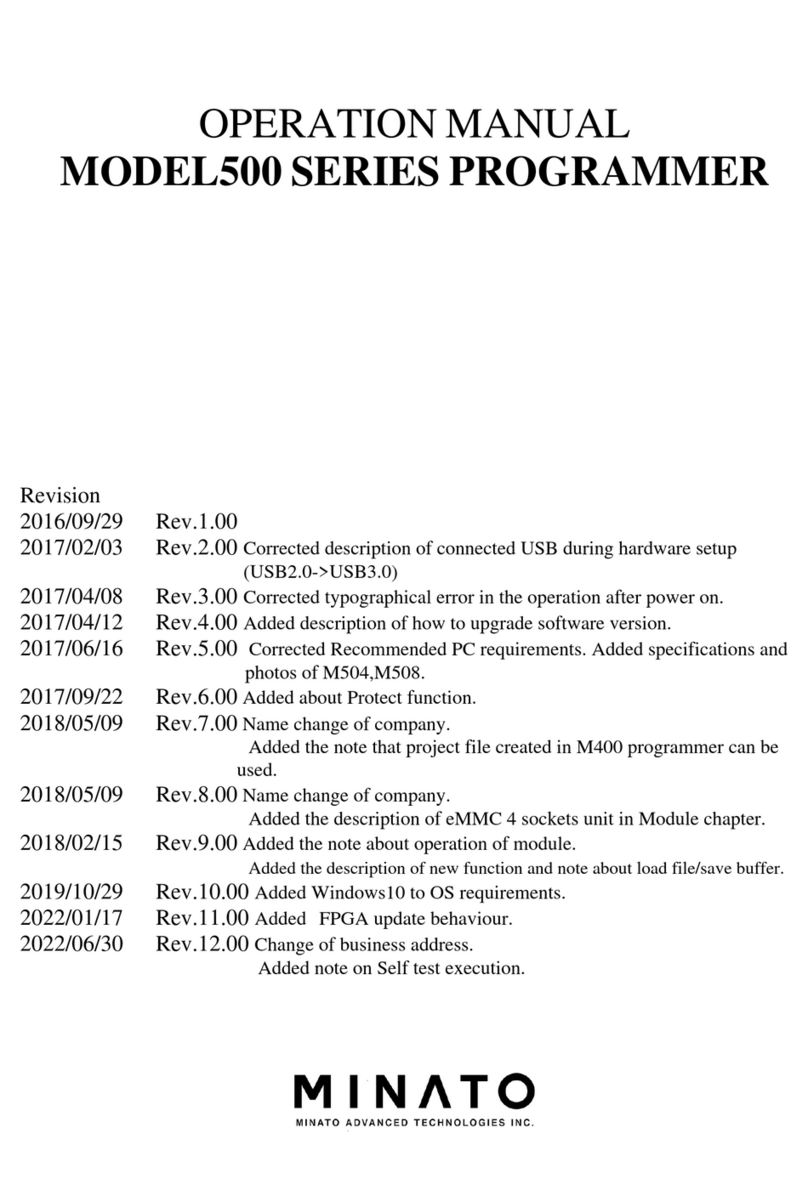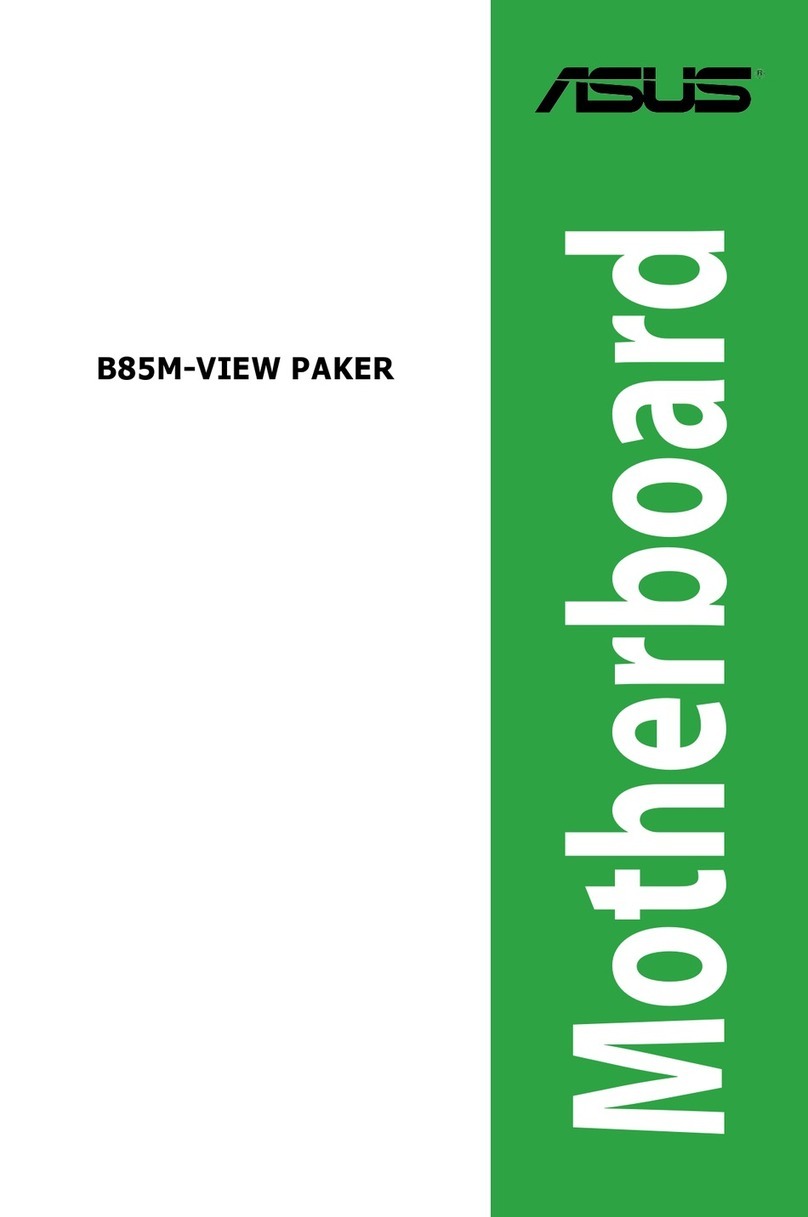MINATO 1866 User manual

INSTRUCTION
MANUAL


WARRANTY
MINATO
ELECTRONICS Programmer
is
guaranteed against defect in
materials and workmanship.
The warranty period
for
the Model 1866
is
one
(1
) year.
The warranty period begins upon receipt
of
the programmer.
During one (1) year period,
if
the Model 1866 requires any repair due
to
defective materials
or
workmanship contact the
sales
representative.

1.
GENERAL·················································
3
2.
SPECIFICATIONS,
..
,................................... 3
3. CAUTION..
..
........
..
............................
..
..... 4
4. EXTERNAL VIEW AND NAMES
OF
PARTS
....· 4
4-1
External
View·····································
4
4-2 Display····......................................... 5
4-3 Key Switches
................................
···.. 5
4-4
Rear
Panel
........................................
· 6
4-5 Bottom
Switches................................
6
5. OPERATION.............................................. 7
6.0PERATION
MODES
...................................
7
6-1
EDIT
Mode........................................
7
6-1-1
PAE
(Programming
address
entry
mode)....
.... 7
6-1-2 CH(Change mode)..·
..................
9
6-1-3 INS(lnsert mode)
....................
·.. 9
6-1-4 DEL(Delete mode)
..................
·.. 9
6-1-5 INIT(INITIALTZE mode)
..............
10
6-1-6
FORMAT
................................
·10
6-1-7 COMP(COMPLEMENT mode) ....·10
6-1-8 SER(SEARCH mode)
................
·10
6-1-9
DEVICE
..................................
·10
6-2 SERI(SERIAL I/O
mode)"""'"''''''''''''''
12
2
6-
2-1
Enteri
ng
Data
..........................
·
12
6-2-2 Outputting
..............................
'12
6-2-3 Issuing List
..............................
12
6-2-4 Outputting Control Code
............
12
6-2-5 Handshake
..............................
12
6-3
COPY···············································12
6-4
BLANK··············································13
6-5 PROG(PROGRAM) Mode
.....................
13
6-6 VER(VERIFY) Mode
............................
13
6-7 CONT(CONTINUOUS) Mode
................
·13
6-8 REM(REMOTE) Mode
.........................
13
6-9 Address Mode Selection
......................
13
6-10
AUTO/STEP Selection......·
..................
14
6-11
Check
Sum
......................................
·14
6-12
Error Messages
..................................
14
6-12-1
Table of error codes
................
·14
6-13
Block
Operations
in
Copy,
Program,
Verily
and
Cont
mode
..
15
6-14 Setting Serial I/O Mode
......................
·15
6-15
Others
..............................................
15
6-15-1
Key Lock
................................
15
6-15-2 Test..···..··....··....····....·..···
..
··..
16
6-15-3 Repeat
..................................
·
16
CONTENTS
6-15-4 Power-on protection
................
·16
6-15-5 Time-out function
................
·....
16
7.
REMOTE
OPERATION
................................
17
7-1
Terminal equipment Connection
............
17
7-2 Start of Remote Operation
..............
·....·
17
7-3 Creating New
Data"""""""''''''''''''''''
17
7-3-1 How to Use Change Instruction ..
17
7-3-2 How to Use Insert Instruction ....·
18
7-4 Modifying
Data""""""""""""""""'"
18
7-5 Deleting Data
............................
·
........
19
7-6 Inserting Data
....................................
19
7-7 Transferri
ng
Data·
........................
·......
20
7-8 Preparing List
....................................
20
7-9 Punching Paper Tape ..·
................
·......20
7-10
Reading Data from Paper Tape
............
·21
7-11
Initializing Memory Contents
................
·21
7-12
Programmer
COntrol
....·
........................
21
7-12-1
Operation
Address
Range
Specification
........
21
7-12-2 Blank Check ........·
..................
21
7-12-3 Program..··....·....··
..
··....·....··....
22
7-12-4 Verify
....................................
·22
7-12-5 Copy
......................................
22
7-12-6 Cont
......................................
22
7-12-7 Format Specification
..............
·..
22
7-12-8 PTR Verify
..............................
22
7-12-9 Buffer's check sum
..................
22
7-12-10
PROM device select
................
22
7-12-11
Address select
........................
22
7-12-12
EEP-ROM's erase
....................
22
7-12-13
EEP-ROM's byte erase
............
·22
8. SERIAL INTERFACE
..................................
'23
8-1
Introduction ....·
................
·
................
·23
8-1-1 Serial ifF ratings
......................
23
8-1-2 Setting the serial flF
..............
·
..
24
8-1-3 Serial ifF selection
..................
·25
8-2 RS-232C Level Interface
......................
25
8-2-1
Descriptions
of
interface
signals
........
·25
8-2-2 Interface signal output
..............
26
8-2-3
Connection
to
external
equipment
......·27
8-2-3-1
Connection
with
data
terminal
equipment
..·28
8-2-3-2
Connoction,,~daIa
COIllmlJ1ication~iJlllent·
'31
8-3 Current Loop Interface
......................
·..33
8-3-3
Example
of
connection
with
external
equipment
......
35
8-4 Serial flF Cable
........................
·........·35
8-4-1 Serial I/F Connector
..........
·....·
..
35
8-4-2
Table
of
serial
ifF
Connector
pins
....36
8-4-3
Cable····································
'37
8-5
Control
Method
and
Transmission
Protocol"'38
8-5-1 Control method
........................
38
8-5-2 Transmission protocol
..............
'40
8-5-2-1 Non-control
................
"40
8-5-2-2 X-ON/X-OFF control......
·4O
8-6 Instructions in Remote Mode
................
44
8-6-1 Remote Instructions
..................
44
8-6-2 Instructions description
............
·44
8-6-2-1
Instructions
for
deta
transfer········44
8-6-2-2
Instructions
for
P·ROM
control·····
·45
8-6-2-3
Buffer
operation
instructions·····
..
'45
8-7 Instructions in Serial Mode
................
·..46
8-7-1 Data format reception
..............
·47
8-7-2 Data format output
..................
-47
8-7-3 List output
............................
"47
8-7-4 Control code output
..................
47
8-7-5
Error
......................................
48
8-8 Data
Fomnat
........
·
..............................
49
8-8-1 Output format
........................
"49
8-8-2 Formats description
................
"50
1.
TEKTRONIX
HEX.
(8 bits) ........·50
2.
INTEL
HEX
..........................
·..
51
2-1
INTEL
HEX.
(8/16 bits) ........
51
2-2 INTEL
HEX
.......................
52
3.
MOTOROLA
........................
"'53
3-1
Motorola Exerciser......·......53
3-2 Motorola Exermax
(16
bits)"'53
4.
TEXAS SDSMAC
....................
54
5.
MINATO
HEX
......................
"'54
6.
ASCII-HEX.......
··
..
·....
··
....·
..
·
..
"55
6-1 ASCII-HEX
(SPACE),
V1
......55
6-2 ASCII-HEX
(SPACE),
V2
......55
6-3 ASCII-HEX
(SPACE),
V3
......55
6-4 ASCII-HEX
(SPACE),
V4
......55
7.
BINARy
..............................
"'55
8.
HP-64000 ABSOLUTE
............
·'56.
8-3-1 Current Loop Interface
..............
·33 9. Displays and
PROMs
to
be
Programmed
........
..
8-3-2
Current
Loop
interface
signal
output·····34 Contained
in
the pocket at back
of
the rear cover.

1 GENERAL
The
Model
1866
EPROM
Programmer
is
a PROM
programmer
which
incorporates
8 bit micro-processors
and
current
state-of-the-art
LSls
at
its
control
section
and
avails itself
of
their
functions
fully.
The
object
to
be
programmed
includes EPROMs/EEPROMs
from
16
k
to
256
k-bits.
The
1866
Programmer
is
provided
with
an
interface
RS232C
2
SPECIFICATIONS
o CPU Z-80A (4.0MHZ)
o
Buffer
RAM
32
k-
bytes
(256 k- bits)
o
Monitor
RAM 2 k-bytes
o
Monitor
ROM 8 k-bytes
o
Operation
switch
Hexadecimal key
switch
o Display LED
o
Interface
Ser
i
al
: RS-232C,
20mA
o
Baud
rate
o
Tape
format
o
Tape
parity
o
Check
function
o
Temperature
o
Power
supply
o
Power
consumption
o Size
o Weight
Cu
rrent
loop,
switch
selectable
110
,
300,600,1200,2400,4800,
9600
switch
sel
ectable
11
kinds
of
formats,
selectable
from
keyboard
Odd,
even,
no
parity
switch
selectable
Memory
test,
Power
test,
Reverse
inertion
test,
programmer
self
test,
Others
+5
to
+35
°C
AC
90V
to
130V
or
1
80V
to
270V
(±10%
),50
/
60Hz
30VA
280(W) x
208(D)
x
70(H)
(mm)
1.5kg
for
outside
service.
If
it
is
conn
e
ct
ed
to
a
computer,
pro-
grammed
data
may
be
transferr
ed
with
ease
from
memories,
disks, etc.
of
the
comput
er
ther
e
into.
It
is
provided
with
a
32
k-byte
programming
buff
er
memory,
permitting
data
up
to
256
k-bits
to
be processed.
The
1866,
owing
to
its small size
and
light
weight,
may
be
transported
with
ease,
and
may
be used
in
wide
applications.
3
Table of contents
Other MINATO Motherboard manuals




















